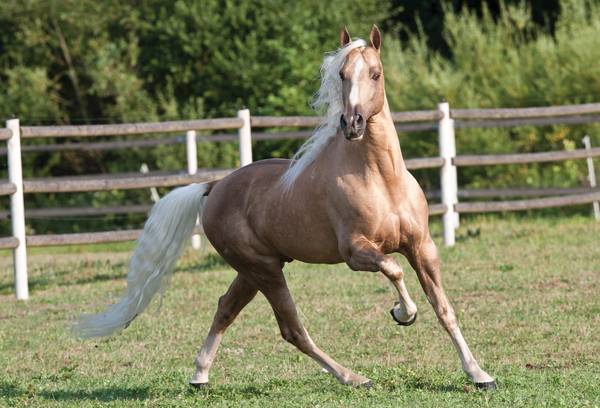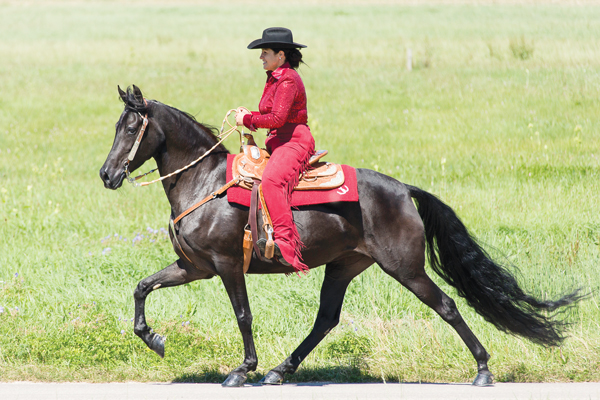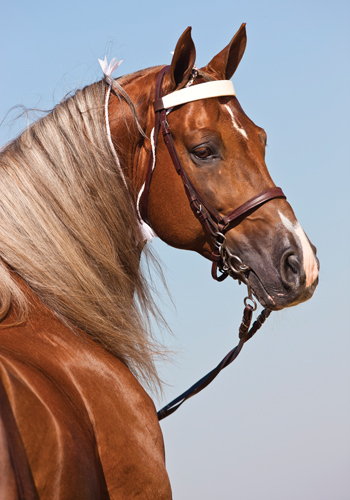Not long after the birth of America, a special horse, the Tennessee Walking Horse, was created in the rural South. Carrying the blood of the Narragansett and Canadian Pacer, along with the genes of the Standardbred, Thoroughbred, Morgan Horse and American Saddlebred, this new horse had the strength and endurance to carry a rider through miles of farmland, all while moving at a smooth gait easily sustainable for hours.

In 1935, the Tennessee Walking Horse Breeders’ and Exhibitors’ Association (TWHBEA) was formed to help record bloodlines and promote the breed as a pleasure riding and show horse. In 1954, the breed was recognized by the United States Department of Agriculture, and the TWHBEA as the official breed registry. Studbooks were closed in 1957, requiring all registered foals thereafter to parentage qualify.
Tennessee Walking Horse Gaits
Tennessee Walkers are born able to perform their special gaits: The flat-footed walk, the running walk and the canter are the breed’s three natural styles.
The flat-footed walk is similar to the regular walk in that each hoof hits the ground separately. The flat-footed walk is also a lot faster than a regular walk, in large part because of its longer strides. While traveling at this ground-covering gait, the Tennessee Walker’s head bobs up and down in rhythm with its steps.
The four-beat running walk is the breed’s most famous gait. As in the flat-footed walk, each hoof also hits the ground separately in a four-beat rhythm. This gait is faster than a trot and much smoother. Tennessee Walking Horses can travel anywhere from 10 to 20 miles per hour at the running walk.
The breed’s third gait is the canter. Unlike the canter in most other breeds, the Tennessee Walking Horse’s canter is more relaxed and has more spring and rhythm, giving the rider the sensation of sitting in a rocking chair.

Versatility in Different Disciplines
Tennessee Walking Horses were originally bred to be ridden long distances around Southern plantations. Today, the breed has adapted to several different disciplines that call upon its inherent talents.
Trail riding is probably the most popular activity for Tennessee Walking Horses. They are able to provide their riders with long, comfortable days in the saddle. The breed’s tractable temperament also makes them good choices for the trail. They are often seen participating in endurance riding and competitive trail events, as well.
Showing has always been an important job for the Tennessee Walking Horse, and the breed excels in a number of competitive disciplines.
In 1998, the National Walking Horse Association (NWHA) was formed with the goal of providing a safe and fair showing environment for the Tennessee Walking Horse. At the NWHA National Show, classes are offered in dressage (both traditional and western), trail obstacle, plantation, pleasure, equitation, costume, leadline, pole bending, barrel racing, reining, and stock seat equitation, in addition to traditional Tennessee Walking Horse classes such as racking and park.
Tennessee Walkers also do well at open shows competing with other breeds, especially at gaited competitions.
With its smooth gait and easy-going temperament, the Tennessee Walking Horse has won the hearts of many equestrians over the years. This all-American breed has been with us since the dawn of our nation, and will no doubt continue to be a mainstay in the horse world in the decades to come.
Tennessee Walking Horse Characteristics and Fast Facts Height: 14.3 to 17 hands Color: All horse colors, pinto and roan patterns Overall Appearance: Straight facial profile with small ears; a long, sloping shoulder and hip; short back; short, strong coupling. Bottom line is longer than the topline. Associations: |
Key Takeaway
With its smooth gait and easy-going temperament, the Tennessee Walking Horse has won the hearts of many equestrians over the years. This all-American breed has been with us since the dawn of our nation, and will no doubt continue to be a mainstay in the horse world in the decades to come.
This article appeared in the November 2019 issue of Horse Illustrated magazine. Click here to subscribe!






